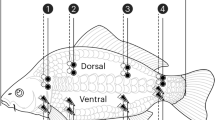Abstract
Background/Objectives:
In this study, we aimed to validate the accuracy of single-frequency bioelectrical impedance analysis (SF-BIA) at 50 kHz to assess total body water (TBW) against the reference technique deuterium dilution (D2O) and to explore if the simple clinical parameters extracellular fluid (ECF) composition and body shape explain individual differences between D2O and SF-BIA ().
Subjects/Methods:
We assessed TBW with D2O and SF-BIA in 26 women and 26 men without known disease or anomalous body shapes. In addition, we measured body shape with anthropometry and ECF composition (osmolality, albumin, glucose, urea, creatinine, sodium and potassium).
Results:
On group average, SF-BIA to predict TBW agreed well with D2O (SF-BIA, 39.8±10.1 l; D2O, 40.4±10.2 l; and −0.7 l). In four individuals (‘outliers’; 15% of the study population), was high (−6.8 to +3.8 l). was associated with individual variations in body shape rather than ECF composition. Using gender-specific analysis, we found that individual variability of waist circumference in men and arm length in women significantly contributed to . When removing the four ‘outliers’, these associations were lost.
Conclusions:
In the majority of our sample, BIA agreed well with D2O. Adjusting for individual variability in body shape by anthropometrical assessment could possibly improve the accuracy of SF-BIA for individuals who deviate from mean values with respect to body shape. However, further studies with higher subject numbers are needed to confirm our findings.
This is a preview of subscription content, access via your institution
Access options
Subscribe to this journal
Receive 12 print issues and online access
$259.00 per year
only $21.58 per issue
Buy this article
- Purchase on Springer Link
- Instant access to full article PDF
Prices may be subject to local taxes which are calculated during checkout

Similar content being viewed by others
References
Boschmann M, Steiniger J, Hille U, Tank J, Adams F, Sharma AM et al. Water-induced thermogenesis. J Clin Endocrinol Metab 2003; 88: 6015–6019.
Kyle UG, Bosaeus I, De Lorenzo AD, Deurenberg P, Elia M, Gomez JM et al. Bioelectrical impedance analysis—part I: review of principles and methods. Clin Nutr 2004; 23: 1226–1243.
Sun SS, Chumlea WC, Heymsfield SB, Lukaski HC, Schoeller D, Friedl K et al. Development of bioelectrical impedance analysis prediction equations for body composition with the use of a multicomponent model for use in epidemiologic surveys. Am J Clin Nutr 2003; 77: 331–340.
Westerterp KR . Body composition, water turnover and energy turnover assessment with labelled water. Proc Nutr Soc 1999; 58: 945–951.
Bland JM . Statistical methods for assessing agreement between two methods of clinical measurement. The Lancet 1986; 8: 307–310.
Berneis K, Keller U . Bioelectrical impedance analysis during acute changes of extracellular osmolality in man. Clin Nutr 2000; 19: 361–366.
Haas V, Engeli S, Hofmann T, Riedl A, Haufe S, Kast P et al. Variations in truncal body circumferences affect fat mass quantification with bioimpedance analysis. Eur J Clin Nutr 2012; 66: 196–200.
Lukaski H United States Department of Agriculture. Agricultural Research Service 1997. Version 23.08.2011 (Internet: http://www.ars.usda.gov/research/publications/publications.htm?seq_no_115=85478 (accessed 24 August 2011).
Fuller NJ, Elia M . Potential use of bioelectrical impedance of the ‘whole body’ and of body segments for the assessment of body composition: comparison with densitometry and anthropometry. Eur J Clin Nutr 1989; 43: 779–791.
Toselli S . Estimation of body composition from bioelectrical impedance of body segments. Int J Anthropol 1999; 14: 71–82.
Zhu F, Kuhlmann MK, Kaysen GA, Sarkar S, Kaitwatcharachai C, Khilnani R et al. Segment-specific resistivity improves body fluid volume estimates from bioimpedance spectroscopy in hemodialysis patients. J Appl Physiol 2006; 100: 717–724.
Acknowledgements
The study was funded by Medi-Cal Healthcare GmbH, Karlsruhe, Germany and the German Obesity Network of Competence (Collaborative Project ADIPOSETARGET, 01GI0830, German Ministry of Research and Education).
Author information
Authors and Affiliations
Corresponding author
Ethics declarations
Competing interests
The authors declare no conflict of interest.
Rights and permissions
About this article
Cite this article
Haas, V., Schütz, T., Engeli, S. et al. Comparing single-frequency bioelectrical impedance analysis against deuterium dilution to assess total body water. Eur J Clin Nutr 66, 994–997 (2012). https://doi.org/10.1038/ejcn.2012.96
Received:
Revised:
Accepted:
Published:
Issue Date:
DOI: https://doi.org/10.1038/ejcn.2012.96
Keywords
This article is cited by
-
Making the choice between bioelectrical impedance measures for body hydration status assessment
Scientific Reports (2021)
-
A novel method of utilizing skinfolds and bioimpedance for determining body fat percentage via a field-based three-compartment model
European Journal of Clinical Nutrition (2018)


